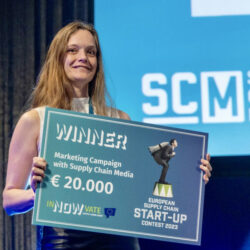SCM Partner Meeting: embrace technology, but don’t forget the human factor

Once a year, Supply Chain Media (SCM) invites all partners to explore trends in supply chain and marketing together. At IG&H headquarters, it became apparent that technology such as artificial intelligence (AI) is playing an increasingly important role in both areas. This is precisely why trust is becoming an important currency, argued SCM’s marketing specialist Nicole Messink (pictured): ‘People do business with people. Therefore, show who you are and what you stand for.’
By Marcel te Lindert
The SCM Partner Meeting opens with a beautiful picture of ants. These insects are capable of collaboration like no other. If necessary, they even use their own bodies to build bridges. Chief trendwatcher Martijn Lofvers of SCM chose this photo for a reason. ‘You might think you are all sitting here among competitors,’ he says, addressing the partners. ‘But I advise you, above all, to collaborate. Together, you will achieve much more.’
Ecosystem mapping
Collaboration helps businesses respond to supply chain developments. Those are largely the result of numerous black swans in recent years, from the pandemic four years ago to the ongoing wars in Ukraine and Gaza. ‘The CSRD is another black swan. Not for the publicly listed companies who know they have to comply with it, but for their suppliers who suddenly also have to provide data.’
Lofvers advises the partners to analyse the implications of such geopolitical developments. For example, what does it mean that Donald Trump won the US presidential election? ‘Just like in chess, you have to think five moves ahead. That helps you to visualize your ecosystem. That consists not only of customers and suppliers, but also other stakeholders such as governments, banks, knowledge institutions and NGOs. And don’t just look at where the weakest links are, but also focus on the strongest links. That’s where opportunities for synergy arise.’
Access to new contacts
Consulting firm IG&H, hosting the SCM Partner Meeting for the second time, explains why it chose to partner with Supply Chain Media. ‘We have grown significantly in recent years and changed from a traditional consultancy into a consulting and technology company. With the broadening of our business, the need arose for a partner to give us access to the supply chain domain. This has resulted in new contacts that have led to concrete projects. In addition, the partnership helps us stay abreast of supply chain innovations,’ says Jasper van Rijn, Managing Director of IG&H.
As a partner, IG&H is a major contributor to the rankings of the Top 26 SCM Directors in the Netherlands and the Top 28 SCM Executives in Europe. The consultancy manages the database containing the profiles of the 300 supply chain executives eligible for these rankings. Using AI, it automatically tracks how visible these executives are. How often do they post on LinkedIn or get quoted in articles? How often do they give a presentation or guest lecture?
Solving problems with stock
IG&H links that data to the performance of the companies concerned. ‘That helps us understand how the sectors in which those companies operate are developing,’ Van Rijn explains. ‘We do this using orbit charts. From these, we can see, among other things, that in the case of consumer goods manufacturers, the inventory turnover rate is decreasing relative to profitability. That basically means that these companies are solving the post-pandemic problems by keeping more stock.’
In contrast, this effect is not visible in retail. In this sector, the inventory turnover rate keeps pace with profitability. ‘With their inventory control capabilities, retailers have unmatched ability to move with market demand,’ Van Rijn explains. ‘So working with Supply Chain Media not only gives us access to new markets and new relationships, but also results in new insights that help us stay relevant.’
Building trust through personal branding
Collaboration also helps to respond effectively to marketing trends. One trend that has been going on for some time concerns the phasing out of third-party cookies. After Safari and Firefox, Google Chrome is expected to be the next web browser to completely stop using cookies. This will force companies to track and reach their target audience in a different way. ‘We have therefore started collecting first-party data in Google Looker Studio,’ states marketing specialist Nicole Messink. ‘This shows, among other things, that 13.2% of our newsletter readers choose to download a checklist, roadmap, mindmap, ecosystem or other item we’ve created together with partners. A very high percentage.’
Another trend is AI, which will also play a role in marketing. At a time when fact and fiction are not always easily distinguishable, trust is becoming a valuable currency, according to Messink. ‘One of the ways to work on that is personal branding. Tell people who you are and what you stand for, and share your expertise. You can do this on LinkedIn, of course, but your target group will also manage to find you on TikTok or Instagram. People do business with people they trust, who share the same values. Personal branding is becoming an important way to build thought leadership.’
‘Don’t forget the human touch’
Does that mean we will stop using ChatGPT in marketing? ‘I don’t think so. I myself work with ChatGPT every day. It is one of my most productive colleagues, although it did take me a while to onboard it properly,’ says Messink. ‘But despite all the numbers, dashboards and algorithms, we all remain human beings. Embrace technology and learn to use it, but don’t forget the human touch, empathy and creativity. Because at the end of the day, people do business with people.’










